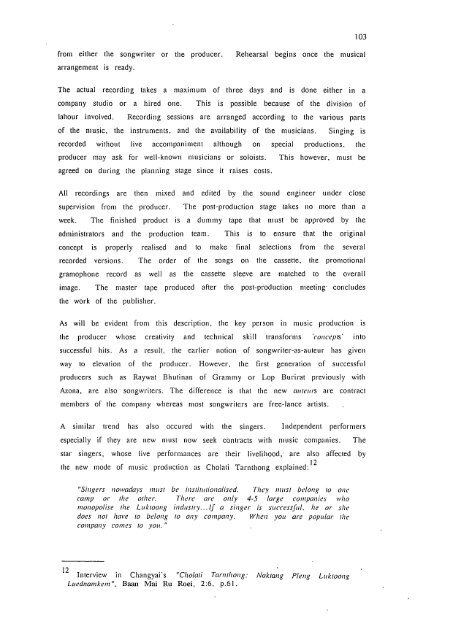iieiiei1eWrkers - Leicester Research Archive - University of Leicester
iieiiei1eWrkers - Leicester Research Archive - University of Leicester
iieiiei1eWrkers - Leicester Research Archive - University of Leicester
Create successful ePaper yourself
Turn your PDF publications into a flip-book with our unique Google optimized e-Paper software.
from either the songwriter or the producer. Rehearsal begins once the musical<br />
arrangement is ready.<br />
The actual recording takes a maximum <strong>of</strong> three days and is done either in a<br />
company studio or a hired one. This is possible because <strong>of</strong> the division <strong>of</strong><br />
labour involved. Recording sessions are arranged according to the various parts<br />
<strong>of</strong> the music, the instruments, and the availability <strong>of</strong> the musicians. Singing is<br />
recorded without live accompaniment although on special productions, the<br />
producer may ask for well-known musicians or soloists. This however, must he<br />
agreed on during the planning stage since it raises costs.<br />
All recordings are then mixed and edited by the sound engineer under close<br />
supervision from the producer. The post-production stage takes no more than a<br />
week. The finished product is a dummy tape that must be approved by the<br />
administrators and the production team. This is to ensure that the original<br />
concept is properly realised and to make final selections from the several<br />
recorded versions. The order <strong>of</strong> the songs on the cassette, the promotional<br />
gramophone record as well as the cassette sleeve are matched to the overall<br />
image. The master tape produced after the post-production meeting concludes<br />
the work <strong>of</strong> the publisher.<br />
As will be evident from this description, the key person in music production is<br />
the producer whose creativity and technical skill transforms 'conccpls' into<br />
successful hits. As a result, the earlier notion <strong>of</strong> songwriter-as-auteur has given<br />
way to elevation <strong>of</strong> the producer. However, the first generation <strong>of</strong> successful<br />
producers such as Raywat Bhutinan <strong>of</strong> Grammy or Lop Burirat previously with<br />
Azona, are also songwriters. The difference is that the new auIeu, are contract<br />
members <strong>of</strong> the company whereas most songwriters are free-lance artists.<br />
A similar trend has also occured with the singers. Independent perforniers<br />
especially if they are new must now seek contracts with music companies. The<br />
star singers, whose live performances are their livelihood, are also affected by<br />
the new mode <strong>of</strong> music production as Cholati Tarnthong explained: 12<br />
"Sin t'ers nowadays inns! be institutiotialised. They nuts! belong to one<br />
camp or the other. There are only 4-5 large companies who<br />
monopohise the Lukioong industry... If a singer is successful. he or she<br />
does no! have to belong to any company. When you are popular the<br />
company comes to you. -<br />
12 Interview in Changyai's "CliolatiTarnihong: Nakiang Pleng Luktoong<br />
Luednonikc,n", Ban Mai Ru Roei, 2:6. p.61.<br />
103














